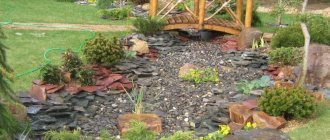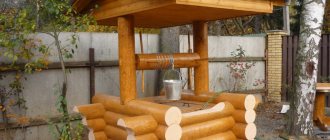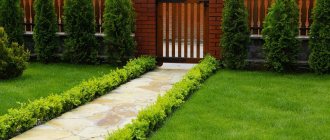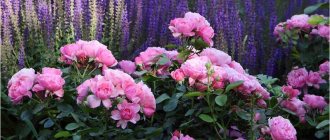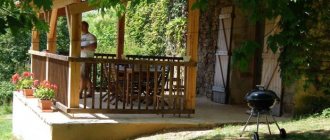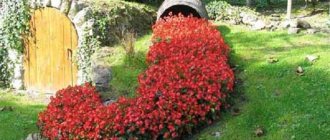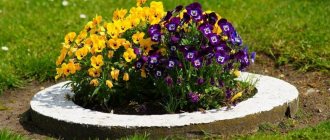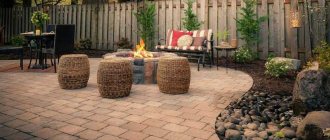Spring is the right time for arranging a personal plot, bringing beauty and creating landscape design. The beauty of a stream in a garden is undeniable. And if you want to enjoy the gentle murmur of water, admire the insects and birds that are attracted to the water, then you need to think through everything wisely. We are talking about the location of the stream, the shape of the banks and its decorative design from beginning to end. Are you afraid that the costs of developing the stream will not be worth it? In this case, we invite you to familiarize yourself with the technology for making dry stream, which came to us from China. From this article you will learn how to make an artificial stream at your dacha with your own hands, both dry and water.
The source of a ringing stream can be a crack in a large boulder, a picturesque bush or a waterfall. In essence, this is a small camouflage of the hose, creating the illusion of a picturesque source created by nature itself. The logical end of the flow is a pond or reservoir. The stream may also disappear under a pile of stones, under which there is a reservoir with a pump. Another option is to make the beginning and end of the source lost in the garden. Of course, this is an artificial source in the country, but it can be made natural in appearance.
Construction principle
When arranging an artificial water stream, one principle is used: a pump pumps water from a reservoir located at the lowest point on the site to the highest point of the stream. After this, the water from the highest point flows down a natural slope.
In order for the construction of a water stream to be successful, it is important to plan it correctly: choose a location and make a slope that ensures the natural movement of water.
If you plan to make a stream that would resemble a natural spring, then use the existing terrain. A water stream can go around garden sculptures and flower beds, flow near trees in the garden or recreation areas, creating small waterfalls, quiet pools, islands, or shallows. By respecting natural forms, you can achieve the naturalness of a stream.
Natural outlines of an artificial stream
Replacing natural outlines with geometry looks unnatural. Such a stream will look more like a ditch.
Before you make a stream, think through all the details. For example, does the terrain allow for the creation of a waterfall? Is there a need for a second pond? Will it be a small stream or will it go around a decent part of the site? The longer the stream, the more equipment you will need to arrange it.
The coast can be decorated with flowering plants. The list of plants that love moist soil includes: hostas, sedge, bergenia, meadowsweet, and bathwort. As for the length and width of the channel, it all depends on you. Standard sizes vary between: width – 0.5–1.5 m, and depth – 0.3–0.5 m.
Decorating a stream with your own hands
After the stream bed has been completed, you can begin to design it. Mandatory materials are stones and plants. It is not necessary to observe symmetry when decorating the bottom and banks with stones; it is appropriate only when creating a dry stream, and then in some cases.
Among plants, the best will be low-growing species . Among those blooming in spring are primroses, muscori, daffodils, dwarf tulips and other small-bulbous ones. Various low cereal plants (fescue, maned barley) and ground cover (phlox, woodweed, saxifrage) look beautiful, especially among stones. You can also pay attention to the assortment used to create an alpine slide.
Separately planted specimens of juniper (creeping forms) and mountain pine will also give the stream a natural look. You can plant a weeping willow at the source.
Arranging the stream in various small forms has also gained popularity . This is, first of all, a bridge, which should not be massive and high, otherwise the stream will be lost against its background. It should look more like a slightly arched or straight crossbar, without railings.
The bridge can be made of wood or stone. There are only decorative structures that cannot support a person, but there are those that can be walked on.
You can also enhance the stream with other sculptures and structures (mill, small stylized houses, stone lanterns). The mystery and enigma of the stream at night will be given by lighting, which should not be bright. It is better to disguise it with stones and plants.
With a little work and time, you will get a wonderful structure that will help you relax after a hard day; the melodic murmur will fill you with calmness, give you vitality and energy.
Calculation of water volume
Due to incorrect calculation of the volume of water, the construction of a ringing stream may fail. It should be taken into account that the pump pumps water over a fairly large distance, which is equal to the duration of the stream. On the way back, the movement of water slows down due to the fact that it goes around stones and plant stems. In addition, water evaporates as it moves. According to some estimates, water in an artificial stream travels only 2 m in 1 minute. For example, when operating a stream 10 m long, 200 to 300 liters of water should be in motion.
Diagram of a stream filled with water
If you decide to independently calculate the volume of water, then take into account the area of the base of the stream, the height of the column of water in the stream and its volume in the hose laid under the stream and supplying water to the highest point of the source and plus the volume of the lower pond.
To ensure smooth operation of the flow, water should be added to it regularly. The need for this is due to water evaporation and ambient temperature.
Video description
The video shows how to build the simplest dry stream with a wooden bridge:
Planting
Without green spaces, a man-made stream will not look complete. Therefore, rocky shores must be framed with plants. Designers recommend using those that are associated with the element of water for this purpose. This could be creeping tenacious, blue fescue, aubrietta, large-leaved forget-me-not. The banks are decorated with any low-growing shrubs. The lower tier is filled with flowering plants. The main thing is to compose the composition in such a way that, as it grows, it does not cover the stream itself.
Green frame of a dry stream Source pinterest.com
stream of flowers
Such compositions invariably become the center of the landscape. Here you can use your imagination to the fullest and create whatever you want. If you choose abundantly flowering plants with blue, blue or lilac inflorescences, you can create cool streams of water. Loberia, Portenschlag bellflower, gray fescue or lavender are best suited for these purposes.
White flowers (alyssium, carnation grass, cornflower), if planted near large stones, will allow the formation of light foam. The following photo will demonstrate what effect can be achieved.
Flower streams - the center of landscape design Source desktopbackground.org
Dry stream. Garden decoration in the spirit of the East
This is one of the original elements of the landscape. It's very easy to do. It will take a minimum of time and money to arrange the arrangement, which is important. A dry stream will decorate the garden plot, hide imperfections in the relief and visually increase the area around the house. Mosquitoes love to swarm over real bodies of water, but these insects have nothing to do near a dry stream.
If you properly arrange a dry stream, the effect from it will be no worse than from a water source. It seems like just yesterday crystal water flowed in it. It feels like a little rain will fill the stream with life-giving moisture, restoring life to it.
Dry streams are quite popular in China. They are the central elements of rock gardens, a symbol of water and continuous movement. In the East, a landscape is considered incomplete without water or its imitation. A dry stream is an excellent alternative for gardens where it is impossible to build a real pond.
Japanese style stream
Some advantages:
- A dry stream harmonizes with any landscape design.
- Plays the role of a drainage ditch without the need to invest extra time, labor and money.
- Possibility of arrangement on hills and depressions, in the sun or in the shade.
- An artificial dry stream can be made in just a few days.
- There is no need to level the landscape, lower the relief or deepen the riverbed.
- There is no need to purchase a pump and accessories for pumping water.
- Possibility of planting any plants, not just moisture-loving ones.
Another feature of dry streams is the possibility of developing a dry lake. The bed of the stream and the bottom of the lake can be lined with crushed stone, and the banks can be decorated with large stones.
Care
Caring for a dry stream is not difficult. It is enough to keep it clean. Weeds will not grow from below, because the top layer of soil has been removed and covering material has been laid. But weeds can sometimes appear on top. As necessary, clear them, as well as any fallen leaves from stones and the surrounding area.
If there are plants along the banks, then they also need to be periodically weeded, watered and fertilized, if necessary for the selected varieties.
With minimal care, your stream will look attractive for many years.
It is also advisable to sometimes lift large stones and check whether ant families have settled under them. They need to be destroyed, without allowing the ants to disturb the created beauty of the landscape design and the dry stream that you so diligently made with your own hands.
Construction of a dry stream
First, decide on the shape and size of the stream, the location and materials for its construction. When choosing a shape and size, consider not only the topography of the garden plot, but also its area. A dry lake, for example, fits harmoniously into a narrow area. And a winding stream looks great on a wide area, creating the effect of lengthening it.
A dry body of water must have a mouth and a source. As for the mouth, it can be hidden behind the large leaves of hosta, bergenia or other plants, while the source should be on a hill. Make a small depression, lining it with fine gravel. In this simple way you will create a semblance of a well, the illusion of a water source.
Step-by-step creation of a decorative element
To create a beautiful dry stream with your own hands, you will need the following set of tools and materials:
- Sand, especially if there are not enough stones.
- River or sea pebbles. Today you can buy ready-made stone, cut for the construction of a dry stream.
- Pegs and cord for marking the territory.
- A shovel is useful for removing the surface layer of soil.
To prevent the growth of weeds, it is necessary to lay geotextiles, so care should be taken to ensure its availability at the preparatory stage.
Tire Pond
If you have no place to make a stream, then do not despair. You can always make a small pond on your property. To arrange it you will not need a large area. One of the simplest options for constructing a pond is to make it from tires.
Determining the location
The best option for arranging an artificial pond is a flat area without hillocks, holes, bushes and stones. If there is none on your site, then clear the place for the pond and, if necessary, level the area.
Tire sizes vary, so decide on the size of your pond in advance. If you have enough space on your personal plot, then make a complex of small ponds located on the same territory.
It is important to decide whether the pond will be in-ground or above ground. All this should be thought through in advance. The choice of decor and purchase of materials will depend on this.
A pond can become a worthy decoration of the garden and an excellent place for relaxation with the whole family. In addition, the pond must be made in the same style as the landscape. Otherwise, it will look ridiculous on the site. All this is important to determine at the planning stage of the construction of this structure.
Manufacturing process
When choosing a location for arranging a pond, consider the following points:
- Soil structure and groundwater level.
- Dimensions of the land plot.
- Pond dimensions.
- Landscape relief.
The place for the pond should be shaded. This is due to the fact that direct sunlight promotes the proliferation of microorganisms in water. And water from a pond located in the sun will quickly evaporate in the summer.
Before determining the location of the tire pond, observe solar activity on the site during the day. So, you will accurately determine the best place for construction.
If the pond will be illuminated or a fountain will be installed in it, then make sure in advance that the electrical connection is located near the pond.
Selecting tires and tools
The choice of tire depends entirely on the size of the pond. A small pond is made from a car tire. For a larger pond, you will have to purchase a tire from a KamAZ, bus or tractor.
Video description
Ready-made ideas for creating streams of flowers in the video:
Additional decoration
An already finished object can be additionally decorated with wooden bridges and stone slabs thrown across the riverbed. Garden sculptures placed along the stream and street lanterns look picturesque. They add a touch of romance and allow you to create an atmosphere of special comfort in the evening.
Wooden bridge over a dry stream Source landscapee.ru
Digging moment
You can safely dig, just remember right away that the walls of the recess should be at an angle of no more than 50 degrees. When digging, throw away the weeds, preferably along with the roots.
Pond with a bridge
To build a bridge over a stream, only natural wood is suitable. If there is an unused log in the yard, this is what you need.
If you don’t like this option, you can make a crossing with your own hands. Or you can leave it as is and lay stones on the surface.

